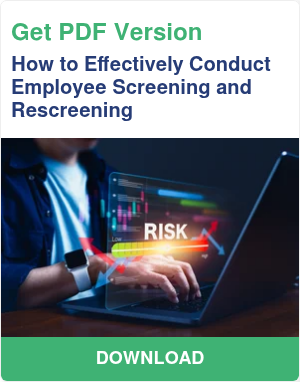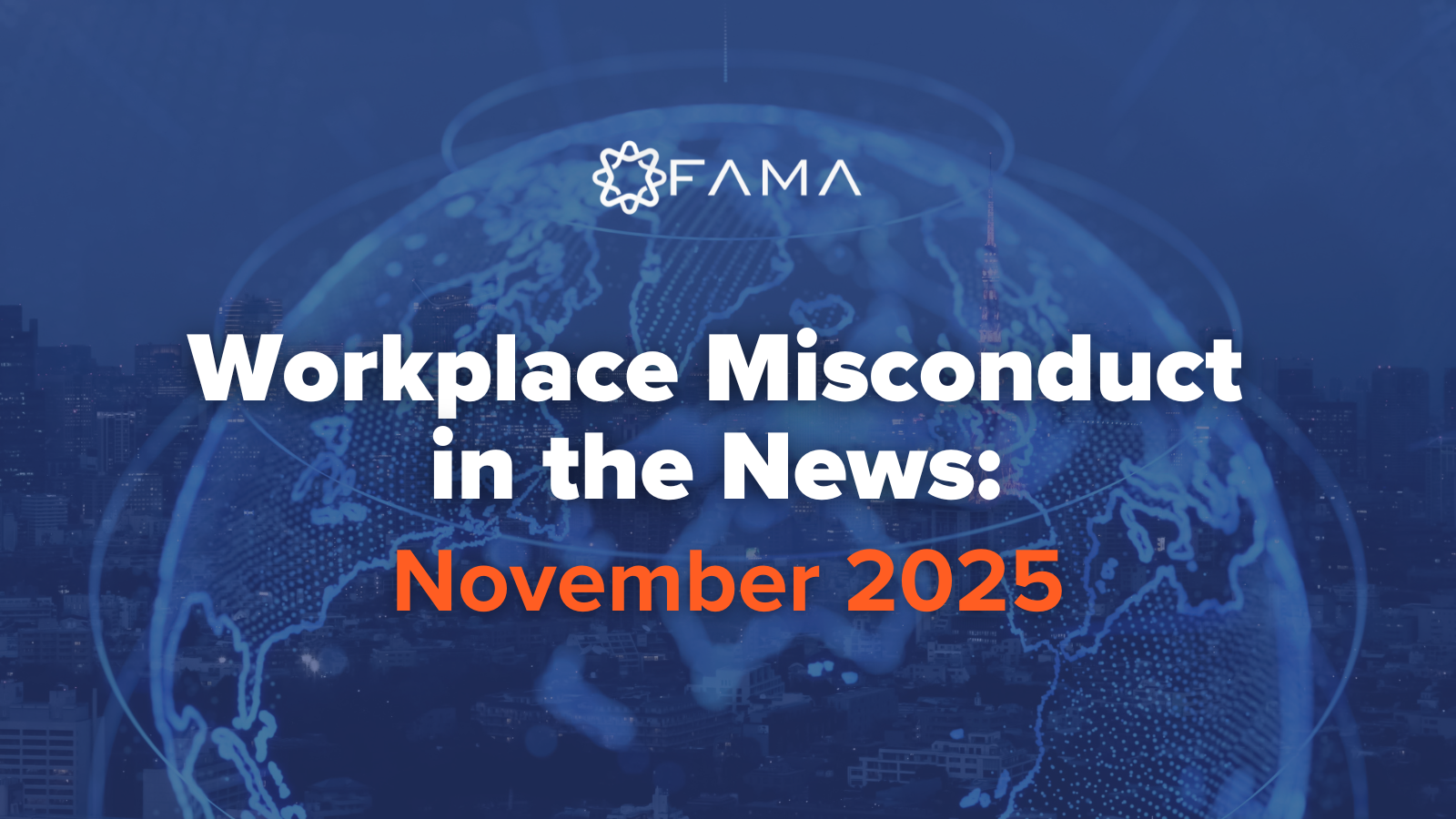How to Effectively Conduct Employee Screening and Rescreening
.jpg)
Pre-employment screening offers a valuable snapshot, but it’s just that: a moment in time. While an initial background check may help surface misconduct indicators before someone joins your organization, it can’t predict how behavior may evolve months, or even weeks, into the job. Today, more people are engaging online than ever, and the risks don’t stop at the point of hire.
That’s why more organizations are rethinking their approach to risk management by adding employee rescreening to the mix. With the right tools and strategy in place, employee screening and ongoing employee rescreening evolve to be more than a compliance measure and become a proactive way to protect your people, your culture, and your bottom line.
The Dynamic Nature of Online Behavior
Although your initial pre-employment screening is a snapshot in time, an employee's online footprint is constantly evolving. We’re living in a digital-first world, and an employee’s online behavior is anything but static. The ever-changing online behaviors require a fundamental shift in how organizations approach risk management, moving beyond a one-time check to embrace employee screening.
As we move toward a workforce dominated by digital natives, projected to make up 75% of employees by 2030, and who increasingly trust the content they consume online, organizations must adapt. Platforms like TikTok, Instagram, and YouTube aren't just entertainment outlets, they’ve also grown into spaces where attitudes are shaped, behaviors are revealed, and risks may emerge, often well after the hiring process ends.
Consider an employee who aced their initial social media background check. However, over time, this person developed new online habits. These changes in online behavior can happen quickly and often in response to local, national or global events. Many companies are changing their screening practices in order to put them in a position to be proactive vs. reactive in order to protect workplace culture, safety, morale, and employer’s reputation.
The implications of relying solely on a single employee background screening are clear. It leaves your organization vulnerable to evolving risks such as violence, threats, harassment, or sexual misconduct that simply weren't present during hiring. This is exactly why employee screening and rescreening are essential.
Why Ongoing Employee Screening Matters
It’s time for businesses to rethink the way they keep their employees and organizations safe. Overlooking the need for proactive employee screening and employee rescreening leaves organizations exposed to a spectrum of evolving threats that can have devastating consequences.
Failing to regularly rescreen current employees can expose your organization to significant risks, some immediate, others with long-term consequences. These include:
- Threats to Workplace Safety: This is perhaps the most immediate and severe concern. An employee whose online behavior reveals emerging violent tendencies, engages in harassment, or promotes discriminatory views can create a hostile and unsafe environment. This isn't limited to physical harm; it extends to the psychological well-being of your team, leading to reduced morale and lower productivity.
- Insider Threats: Employees have access, trust, and influence, making them potential insider threats. While often associated with cybersecurity breaches, insider risk also includes misconduct that compromises integrity and operational stability. Online behavior indicating fraud, extremist affiliations, or illegal activity may signal growing concerns that could expose the company to financial loss, reputational harm, or even physical threats.
- Increased Legal and Compliance Exposure: The regulatory environment around employee conduct is changing, and employers can now be held responsible for off-duty behavior, especially when it creates risk within the workplace. In some industries, continuous background screening is a compliance requirement. Failure to monitor for misconduct throughout an employee’s tenure can lead to negligence lawsuits, regulatory fines, and costly investigations, as demonstrated in cases like Okonowsky v. Garland.
- Reputational Damage: Your employees represent your brand, and their public behavior, particularly online, can either build or erode trust. When misconduct surfaces later in an employee's tenure, whether it’s an offensive social media post or involvement in a public scandal, it can quickly go viral and damage your brand’s image. A single incident can lead to lost customers, shaken investor confidence, and a decline in talent attraction. Ongoing screening helps identify and address reputational risks before they escalate.
- Damage to Productivity and Culture: Unchecked misconduct undermines team trust and organizational culture. When employees see leadership overlook problematic behavior, it signals a lack of accountability, leading to disengagement, increased turnover, and a drop in overall productivity. Even a small number of disruptive employees can have an outsized negative impact on team performance and retention.
Unchecked risk quietly chips away at the foundation of your workplace. To truly protect your organization from reputational, cultural, and operational harm, screening must evolve from a one-time task to a continuous process. In order to accomplish these goals, a structured, proactive approach to employee screening and rescreening is essential.
6 Steps to Conduct Effective Employee Screening and Rescreening
Integrating social media screening into your employee risk management strategy is about building a thoughtful, structured approach to behavioral insight. Done well, it strengthens your culture, reinforces compliance, and helps your team stay ahead of emerging risks. With that in mind, consider the following steps:
1. Define Clear, Compliant Screening Criteria
The strongest rescreening strategies start with a well-documented policy. Be explicit about what you're looking for in both one-time employee screenings or periodic employee rescreenings. This should include clear definitions and criteria for threats, harassment, illegal activity, or breaches of confidentiality, and additional details about what’s not included in these processes.
While an employee’s social media usage may be personal, they still act as an extension of the brand outside of work hours. So, social media usage policies can set transparent expectations that protect both staff and the business. For instance, a social media policy might include:
- Be respectful of others online
- Do not disclose confidential company information
- Do not discuss competitors in a negative manner
- Be mindful of the permanence of online content
Make it known that the focus is public, job-relevant behavior that could impact workplace safety or compliance, not private opinions, personal beliefs, or lawful off-duty conduct. This clarity builds trust with your employees and helps protect your organization from bias or overreach.
2. Set a Sensible Employee Rescreening Cadence
Risk isn't static, so your approach to screening shouldn't be either. Misconduct often progresses quickly, moving from exposure to harmful content to public endorsement and participation in just a matter of months. That’s why many organizations opt for rescreening every 90 days. It strikes the right balance: frequent enough to catch meaningful behavioral shifts, but not so often that it becomes invasive or resource-heavy.
The right cadence may vary based on your industry, risk tolerance, and regulatory environment, but consistency is key to long-term risk mitigation.
3. Obtain Proper Consent
Before initiating any screening or rescreening, ensure your process is legally sound and clearly communicated. Inform employees of your policy and obtain written consent where required. This not only helps you stay compliant with privacy and employment laws but also promotes transparency.
Include screening and rescreening language in your onboarding materials and employee handbooks. Reinforce that the goal is safety, fairness, and compliance, not surveillance.
4. Conduct Regular Training Sessions
A well-informed team is your first line of defense. Regularly train HR leaders, compliance officers, and hiring managers on how employee screening works, what it does and doesn't capture, and how to interpret results ethically and fairly.
Equally important, be sure to provide employees with guidance around your social media policy. Training helps demystify the process and reinforces a culture of trust, accountability, and inclusion.
5. Use Purpose-Built Online Screening Tools
Manual searches are not only inefficient, they also increase the risk of inconsistent results and unconscious bias. Purpose-built tools help organizations analyze public content at scale, using ethical AI to flag only risk-related behavior in a fair, repeatable, and compliant way. These solutions ensure your team is seeing only what matters for both the business’s reputation and the safety of its employees.
6. Put Insights to Work
Employee screening and rescreening isn’t a one-way mirror. It’s a two-way conversation with your culture. Use what you learn to refine your policies, adjust training programs, or proactively support teams. If a pattern of behavior surfaces, whether it’s increased hostility online or signs of disengagement, take the opportunity to check in, recalibrate expectations, or offer resources. These insights can inform everything from digital conduct guidelines to inclusion initiatives to employee wellness efforts.
In cases where flagged behavior raises serious concerns, it’s critical to follow a fair and compliant adverse action process. If disciplinary measures or termination are being considered based on screening results, employers must provide the employee with a pre-adverse action notice, giving them the opportunity to review and respond to the findings. After that, a final adverse action notice must be issued if the decision proceeds. This not only fulfills your legal obligations under the Fair Credit Reporting Act (FCRA) and other applicable laws, it also reinforces transparency, consistency, and fairness in your employee management practices.
Putting best practices into place is only half the equation. To truly embed social media rescreening into your employee listening and risk management strategy, you need the right infrastructure to support it.
Building a Safe Work Environment through Ongoing Employee Screening
Creating a safe, respectful, and compliant workplace doesn’t happen by accident. It requires proactive strategies, clear policies, and the right technology to support them. As employee behavior and digital activity continue to evolve, organizations can no longer rely on one-time background checks conducted early on in an engagement to manage risk. Ongoing employee screening is essential to staying ahead of emerging threats that could compromise workplace culture, safety, or brand reputation.
Now, solutions from Fama are used across industries to analyze publicly available online content and flag behavior that signals risk, respecting employee privacy and avoiding bias. Fama’s platform integrates seamlessly into your existing HR tech stack and delivers actionable insights that help your team make informed decisions, maintain compliance, and protect your culture.
With Fama, you’re not just preventing misconduct–you’re investing in a safer, stronger, and more resilient workplace. Whether you're screening candidates or rescreening current employees, Fama empowers you to see risk before it becomes a problem.
Ready to elevate your risk management strategy? Book a demo to learn how Fama can help your organization proactively build a safe, inclusive, and compliant workplace through ongoing employee screening and employee rescreening.






.jpg)


